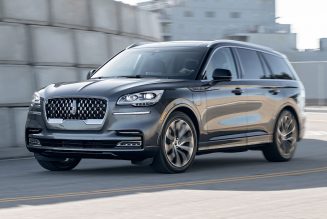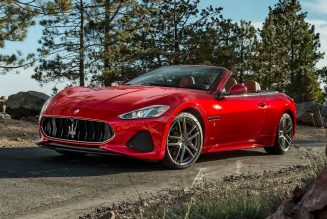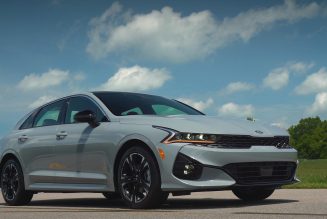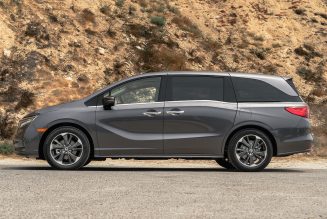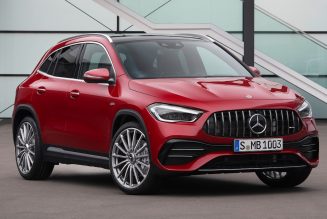Chevrolet Bolt EUV Full Overview
We’ve known the tall-hatch Chevrolet Bolt EV—winner of our 2017 Car of the Year calipers—was getting an SUV sibling for some time now. As details of the 2022 Bolt EUV began to emerge, the MotorTrend internal Slack channels lit up with questions: Why’d Chevy make the two vehicles look so similar? Why is the new one named like a trim level? How does Chevy expect showroom sales personnel to steer buyers into one or the other of these plug-in twinsies instead of a cheaper (perhaps more profitable) gasser of similar size and configuration on the same lot? (Should buyers even consider that choice?) And finally, how is it that the 6.3-inch-longer model features less cargo space? Might a two-hour drive in a high-spec version of the new Chevrolet Bolt EUV answer these questions?
How Does the Bolt EUV Fit Into the E-SUV Landscape?
Stretching the Bolt EV’s wheelbase by 2.9 inches added 3.1 inches of rear legroom, making it roughly as comfortable for four passengers as a Ford Mustang Mach-E or Tesla Model Y and leg-roomier than the new Volvo XC40 Recharge and VW ID4. But because it’s 3 to 6 inches narrower than those vehicles, a third rider in the rear will feel smooshed in the Chevy. Most of those rigs are pricier, and they’re all longer than the Bolt EUV because they generally have longer, prettier snouts (most of which incorporate a frunk). The same will likely hold true for the fetching new Hyundai Ioniq 5, full details of which aren’t out yet. So for now the compact Bolt EUV remains a roomier alternative to the Hyundai Kona EV and a smaller (outside), cheaper alternative to the rest.
How Does the Bolt EUV Fit in the Chevy Showroom?
That oh-so-compact powertrain gives the Bolt EUV Trailblazer-like passenger and cargo cubic footage in a body that’s considerably smaller than a Trax. But because its price aligns better with the bigger, fancier Blazer and buyers have no all-wheel-drive option in any Bolt, salespeople will need to dream up some new arguments about home-charging convenience, simplicity of maintenance, etc. if they’re going to move any Bolt EUVs.
Is This Trax-Sized Blazer-Priced SUV Sufficiently Posh Inside?
My Premier-trim example with the two-tone interior certainly made a great first impression. The contrast yellow stitching and white piping on the seats, not to mention the triangle-shaped perforations on the seat and dash inserts, lend a very upscale look. (Base Bolt EUVs get a monochrome dark gray interior with cloth seats.) The soft-touch stitched material on the dash and doors looks and feels pleasing. There is nice ambient lighting underneath the accent stripe on each door and across the dash. The center screen seems as big as is practical in a car this narrow.
What About the Back Seat?
Even with the front seat pushed all the way back, my 5-foot-10 frame fit comfortably, with remarkable thigh support, a comfy pull-down center armrest, and reasonable seat cushion and backrest comfort. The seat perforations continue back here with heaters (no coolers), but there’s no ambient lighting, no heat or A/C vents, and just two USB outlets—one A and one C type. Another oddity of our high-spec variant: The front seat coolers package where rear passenger toes want to be, behind a sort of fence right at the back of the front seats, that moves back and forth with them.
What’s It Like to Drive?
The extra 6.3 inches and 90 pounds relative to the junior Bolt go unnoticed from the driver’s seat. Floor it, and the two front tires (Michelin Energy Saver A/S in size 215/50R17 as before) struggle for grip, especially when turning. The car zooms away at a pace that always seems quicker than the roughly 6.5-second 0-60 time suggests. A button engages one-pedal driving mode, which provides enough retardation to slow for most normal driving conditions; numbers folks will appreciate that there’s 214 percent more retardation than in Normal mode. Not enough? Pull the regen paddle on the left side of the steering wheel to increase that to 300 percent more. (Simply pulling that paddle in Normal mode gives you 243 percent more slowing.) This combination of modes and switches seems ideal for matching driver expectations with driving situations and should ensure that any Bolt’s brake pads and rotors outlast the car.
The steering feels just as rheostatic as ever, even in Sport mode, which cuts the assist by about 20 percent, but the simple strut front/torsion-beam rear suspension reacts predictably and with reasonable verve. The mass and rigidity of the low-mounted battery undoubtedly contribute to the Bolt’s generally flat handling and taut body feel. Ride quality seems in keeping with this price class—firm, supple, never overly jarring. Would simply moving the motor to the rear improve the Bolt’s dynamics? You bet. But that’s a design tear-up that the Bolt’s razor-thin profit margins will never cover (especially now that GM’s $7,500 tax credits have run out and the price has come down).
What’s It Like to NOT Drive (on Super Cruise)?
Perhaps the Bolt EUV’s greatest unique selling proposition is its Super Cruise feature. Super Cruise comes standard on Launch Edition models ($43,495) and it’s optional on Premier models (adding $2,200 to the $38,495 base price). That makes a Bolt EUV with Super Cruise $8,495 less expensive than the cheapest Tesla with Autopilot and $17,775 less than the cheapest Cadillac (CT5) with Super Cruise. The Bolt EUV is the first non-Cadillac model to get this advanced driver-assist feature, and much of my two-hour experience in the Bolt was spent Super Cruising. The Bolt’s legacy electrical architecture prevents it from getting the latest version now becoming available on Cadillacs, which supports lane changes, but it is a huge stress reliever on long highway drives. It allows those who are determined to look at their phone to do so safely, providing they hold the phone up high enough and off to one side so the driver-monitoring camera on the steering column can verify their eyes are still pointed toward the road. Oh, and for those unwilling to pop for Super Cruise, basic adaptive cruise control will be available for the first time on both the EV and EUV.
How Far Can the Bolt EUV Go on a Charge?
The official EPA results aren’t expected until closer to launch this summer, but GM’s internal testing says 250 miles. My 63-mile test drive spent aggressively probing the limits of acceleration or cruising at 75 mph (a speed that earns an admonishing yellow ring around the speedometer) removed 75 miles of indicated range. Doing some math based on the starting and ending screens suggests that a whole battery’s worth of this driving might result in a range of around 175 miles. One of the best-executed features of the Bolt is its reconfigurable instrument cluster and infotainment screen, both of which can be configured to provide all the information a driver needs to either maximize range or better understand how driving behavior and ancillary accessory usage affect range.
How Do You Charge a Bolt EUV?
The standard charging cord that comes with all 2022 Bolts has a new twist: It plugs into either a standard 110-volt outlet or a NEMA 14-50 outlet (three vertical prongs plus a ground). That type of outlet typically powers an electric range or oven, so if you do not already have such an outlet in your garage, Chevy will cover the cost of installing one. In order for that cord to deliver its full 7.2-kW, the home system needs to be able to support 8-gauge wiring and a 40-amp fuse. Of course, the 2022 Bolt EV and EUV’s onboard charger is now capable of accepting 11.5 kW of incoming AC power, so impatient homeowners that can swing 6-gauge wiring and a 50-amp fuse may want to source their own higher-powered Level 2 charger. A full charge will take about 7 hours on the Chevy-provided 240-volt charger, and the Bolts still accept DC fast charging, which promises to add 95-100 miles of range to a mostly depleted battery in a half-hour. A light at the top center of the dash (and surrounding the charger of Launch Edition models) keeps you apprised of charging progress, periodically blinking: Single blinks indicate 0-25 percent charge, two blinks means 25-50 percent, and so on until switches off to indicate 100 percent charge.
Why’s the Bolt EUV’s Cargo Volume Lower Than the Bolt EV’s?
Short answer: It’s not. In real-world practice, you’ll get about 2 cubic feet more stuff in an EUV. The American SAE cargo volume calculation multiplies length, width, and height dimensions, and the place where height must be measured just happens to be right where the EUV’s hatch hinges are. That’s enough lower than the nearby roof (which is where the Bolt EV gets measured) to offset the EUV’s 3-inch-longer cargo floor. The international DIN standard, on the other hand, fills the cargo hold with little blocks and adds up their volume, which is 59 liters more than the equivalent measure in the Bolt EV. For the record, both the EUV’s 56.9-cubic-foot maximum cargo volume and the EV’s 57.0 cubes rank larger than the Tesla Model Y, which we measure at 54.4 cubic feet, and they come close to the XC40 Recharge (57.5) and Mach-E (59.7)—at least by the SAE yardsticks.
So Why Are the Styling and Nomenclature So Similar?
First, current adopters of the Bolt EV are among the most loyal and satisfied in the Chevy family. Second, the Bolt has attracted more customers to General Motors than almost any other vehicle. These factors heavily incentivized the brand to double down on the general design and name—much the way Toyota has made something of a subbrand of its Prius models.
Should You Reserve a 2022 Chevrolet Bolt EUV?
Whether or not you love the look or the name, there’s little arguing that a Bolt EUV with a 250-mile range gets you a lot of automotive technology for $33,995. And for anyone who endures a long freeway commute to and from work each day, a Bolt EUV with Premier trim and Super Cruise probably represents the biggest vehicular quality of life increase $40,695 can buy.
| 2022 Chevrolet Bolt EUV | |
| PRICE: | $33,995-$43,495 |
| LAYOUT: | Front-motor, FWD, 5-pass, 4-door SUV |
| MOTOR: | 200-hp/266-lb-ft AC permanent-magnet electric |
| TRANSMISSION: | 1-speed auto |
| CURB WEIGHT: | 3,700 lb (mfr) |
| WHEELBASE: | 105.3 in |
| L x W x H: | 169.5 x 69.7 x 63.6 in |
| 0-60 MPH: | 6.5 sec (MT est) |
| EPA FUEL ECON: | Not yet rated (estimated EPA range: 250 mi) |
| ON SALE: | Summer, 2021 |


